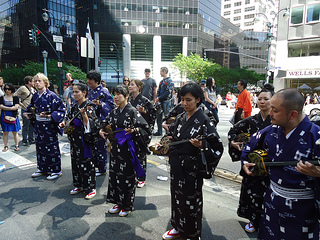Difference between revisions of "Kasuri"
(No difference)
|
Revision as of 02:45, 13 December 2012

- Japanese: 絣 (kasuri)
Kasuri, or ikat, is a style of textile, either in cotton or silk, in which the threads are resist-dyed first, before being woven into the garment, creating geometric and other patterns in a two-tone (e.g. indigo and undyed white) palette. The patterns and techniques were transmitted to the Ryûkyû Islands via India and Southeast Asia, later spawning various regional forms of kasuri textiles in mainland Japan.
Today, Ryukyuan kasuri textiles are chiefly produced in silk, in the Kyan neighborhood of Haebaru-chô, and Teruya in central Okinawa.
In the Ryûkyû Kingdom, the colors and types of aristocratic garments served as an indication of rank. Wives of anji or ueekata wore kasuri or tsumugi garments in green or pale blue (or yellow, for higher-ranking anji families). Pink kasuri garments indicated wives of those of peechin or satunushi status, while the wives of the chikudun, the lowest-ranking nobles, wore blue kasuri.
References
- "Ryukyu-kasuri." Okinawa Compact Encyclopedia 沖縄コンパクト事典. Ryukyu Shimpo. 1 March 2003.